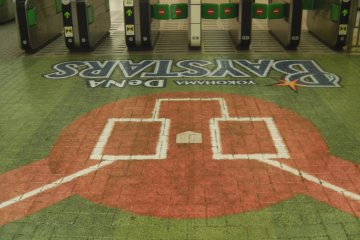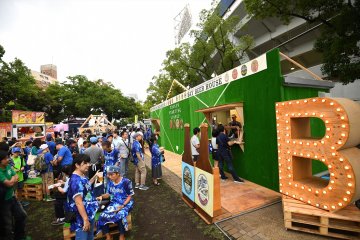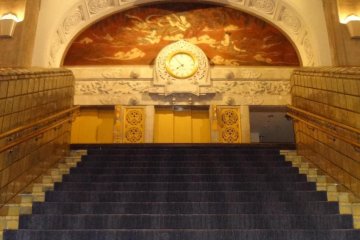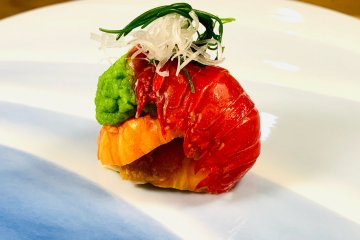
Baystars Game at Yokohama Stadium
Todd WojnowskiThe DeNA Yokohama Baystars' management loves putting on a show at Yokohama Stadium. From DJs to special promotions, attending a game is a full night of entertainment.

Yokohama Stadium is located in Naka-ku, Yokohama, and is a multi-purpose stadium. These are quite rare these days. Yokohama Stadium opened in 1978 and can seat over 30,000 people. Today the stadium is primarily used as a baseball stadium Home field of the Yokohama DeNA BayStars, but American football games and live events also take place there.
The stadium hosted an Australian rules football game and attracted the second largest crowd for such an event outside of Australia.
Numerous artists are already performing in Yokohama Stadium: Santana, Michael Jackson, Tina Turner, Madonna, Luna Sea, Nana Mizuki and ONE OK ROCK are just a few of the well-known names.
A 2-minute walk from the south exit of Kannai Station on the JR Negishi Line; a 5-minute walk from the north exit of Ishikawacho Station on the JR Negishi Line; a 3-minute walk from Exit 1 of Yokohama Municipal Subway Kannai Station; a 3-minute walk from Exit 2 of Nihon Odori Station on the Minatomirai Line.

The DeNA Yokohama Baystars' management loves putting on a show at Yokohama Stadium. From DJs to special promotions, attending a game is a full night of entertainment.

On game day, passion and cheerful energy are in full swing in and around Yokohama Stadium!

At the 2020 Olympic Games baseball and softball matches will be special additional events. Baseball is regarded as a national sport in Japan. Yokohama Baseball Stadium is well located and allows an exploration of the best that Yokohama has to offer.

If you are a baseball lover and have been captivated over the years by the magical performances of Nomo, Matsui, and Ichiro, then you should definitely set aside an evening during your stay in Japan (April-September) to catch a Yokohama Bay Stars night game at Yokohama Stadium.

Bay Beer House is back for 2017, opening at the Hamasta Bay beer garden area for a limited time.

To properly see Yokohama, you need a good quality hotel with a central location. Hotel MyStays Yokohama Kannai is my first choice.

The elegant building facing Yamashita Park, is one of the oldest hotels in Yokohama: the Hotel New Grand.

Conveniently located hotel near of Sakuragichi JR Station with good access to Yokohama's many waterfront shopping, dining and leisure attractions.

Perfect for couples or groups (up to 12 people), Masago provides enticing kaiseki dining that is delicious and artistic. Try their classic Japanese-style cuisine that has been altered for a more international taste while retaining the harmony of its original flavors.

RUCY+R boasts a delicious and colorful vegan menu. You won't be disappointed by the Hawaiian-inspired cafe where you can try Mexican taco salad, tofu-katsu, and curry with an extra kick of veggies.

Enjoy high-quality authentic Chinese food such as dim sum, congee, and noodles at MS. CASABLANCA. This casual Chinese dining space is chic and comfortable, providing high-class Chinese dining in Kanagawa supervised by a Michelin Star chef.

Yokohama Chinatown, also known as Yokohama Chukagai, is Japan’s largest Chinatown. An enclave of Chinese shops and restaurants has stood in this section of Yokohama since the port city was opened to international trade in 1859. The entrance to Chinatown is marked by four intricate and colorful gates, which represent the four directions in Chinese tradition. Each gate is associated with a different mythological animal an additional five gates stand within the neighborhood’s boundaries. More impressive architecture can be found at the Kanteibyo temple (also known as the Guan Gong Temple), which is dedicated to the Chinese god of successful business and prosperity. Built in 1873 by the neighborhood’s residents, it remains popular among the faithful and also welcomes visitors with its serene evening lantern displays. Nearby Masobyo Temple is newer and smaller, but this Taoist temple still impresses with its decorative touches. Chinatown is noted for its cuisine, from humble street stalls to gourmet feasts. Pork or mustard green steamed buns, egg tarts and goma-dango (sesame seed dumplings) all make for popular pick-me-up streets to grab on the go. In the many eateries that line the neighborhood streets, it’s possible to dine on any number of authentic Chinese dishes – spicy mapo tofu, duck, and dozens of dim sum options are just a few of the popular menu items on offer. Several stores in the area offer a unique shopping experience not often found in other Japanese cities. Pick out the perfect good luck charm or try your luck at a fortune teller. Browse the selection of one-of-a-kind “qipao”, a type of traditional Chinese dress. Or, stock your cabinet with a range of Chinese teas. Yokohama Chukagai sees its greatest influx of visitors every winter during the fifteen-day-long Chinese New Year festivities. The neighborhood is justifiably famous for its lavish celebrations, with lion dances, parades and numerous other activities. The streets are often decked out in lanterns and paper dragons; night visits are extremely atmospheric during this season.

Kanteibyo Temple (関帝廟) is a spiritual landmark in Yokohama’s Chinatown. It shines like a beacon of faith with its vibrant red exterior and intricate detailing. Dragon statues stand above the entrance with poised bodies and open mouths, fiercely guarding the temple. The interior is decorated ornately with gold designs, wordlessly speaking of the temple’s significance. In the center sits a statue of Guan Yu, a famous military general turned deity who is immortalized in the historical Chinese novel, Romance of the Three Kingdoms. Worshippers pray to Guan Yu for business and financial prosperity. History Founded in 1862, Kanteibyo was allegedly created when a Chinese migrant brought a statue of Guan Yu to Japan. The temple started humbly as a small shrine but expanded over the years thanks to donations from devout worshippers. Kanteibyo’s history was a turbulent one, as it stood witness to numerous calamities. In 1923, the temple was destroyed by an earthquake; years later it was damaged in 1945 during World War II air raids; and in 1986, it burned down due to an unsolved fire incident. After each destructive event, the town united to rebuild the temple, reflecting the residents’ deep sense of community and connection with each other and the temple. Today Kanteibyo has become entrenched in Chinatown’s legacy and is a frequented site by residents and tourists alike for prayer and admiration. The temple is dedicated to seven deities, all of which--except the Jade Emperor who is symbolized by the ceiling--are represented by lavishly adorned statues. These deities include the Jade Emperor, Guan Yu, Di Mu Niang Niang, Zhou Cang, Guan Ping, Guan Yin, and Fu De Zheng Shen. Centered in the temple is Guan Yu’s statue, which is red-faced, long bearded, and cloaked in brightly-colored attire. The most common way of praying involves the use of incense sticks. While fire is prohibited in the main shrine, worshippers can light the incense sticks outside and place them in five burners corresponding to the shrine’s deities. After lighting the incense, practicers enter the main building and pray to the deities in a specific order. Temple assistants can also help people tell their fortunes with the use of divination moon blocks. The temple holds celebratory events throughout the year with the most popular ones being on New Year, Lunar New Year, and Guan Yu’s birthday. These spectacles are filled with traditional Chinese performances such as lion and dragon dances.

Masobyo Temple (媽祖廟), also called Ma Zhu Miao, is located in Yokohama’s Chinatown. The young Taoist temple, which opened relatively recently in 2006, enshrines Mazu, the Chinese Goddess of the Sea. Despite its young age, the temple exudes ancient spirituality older than its years. The structure has a geometrical base and is decorated with blue, green, red, and gold detailing. A massive gate welcomes visitors and worshippers alike and is connected to the main temple with a line of red lanterns. Inside Masobyo, a statue of Mazu is cloaked in vibrant attire and wearing an imperial headdress, symbolizing her godly status. The interior is equally as impressive as the outside with exquisite designs covering every surface. Worshippers commonly go to the temple to pray for safe travels since, historically, sailors and fishermen would pray to the goddess for calm seas during their journeys. History of Mazu: Goddess of the Sea As a human, Mazu was born in the tenth century and named Lin Mo. According to legend, she was gifted with supernatural abilities, such as predicting the weather, calming storms, and experiencing visions. She dedicated her life to the teachings of Tao and ascended to the heavens at age 28 as a goddess. Mazu has two demon bodyguards, Qianliyan and Shunfenger. Both demons vowed to protect Mazu after failing to defeat her in combat for her hand in marriage. Inside Masobyo, statues of the demon guardians stand to the left and right of Mazu. One, colored red, is positioned in a listening pose with his hand to his ear, while the green colored one is diligently watching, with eyes that seem to scan the temple. Today Worshippers visit Masobyo to pray to Mazu for safe travels, as well as general health and safety. The temple is also a popular spot for tourists due to its traditional architecture and cultural significance in Chinatown. Of course, Mazu’s affinity for keeping travellers safe is appealing to tourists as well. Masobyo’s temple staff are extremely helpful and more than willing to teach visitors the appropriate methods of worship. Individuals who want a closer look at Mazu’s statue are required to buy incense sticks, which they place in five burners. After lighting the incense sticks, they should bow in respect. During New Years, the temple becomes crowded with people participating and watching the festive displays.